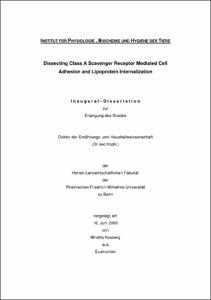Kosswig, Ninetta: Dissecting Class A Scavenger Receptor Mediated Cell Adhesion and Lipoprotein Internalization. - Bonn, 2003. - Dissertation, Rheinische Friedrich-Wilhelms-Universität Bonn.
Online-Ausgabe in bonndoc: https://nbn-resolving.org/urn:nbn:de:hbz:5n-02549
Online-Ausgabe in bonndoc: https://nbn-resolving.org/urn:nbn:de:hbz:5n-02549
@phdthesis{handle:20.500.11811/1866,
urn: https://nbn-resolving.org/urn:nbn:de:hbz:5n-02549,
author = {{Ninetta Kosswig}},
title = {Dissecting Class A Scavenger Receptor Mediated Cell Adhesion and Lipoprotein Internalization},
school = {Rheinische Friedrich-Wilhelms-Universität Bonn},
year = 2003,
note = {Macrophage Class A scavenger receptors (SR-A) are trimeric transmembrane glycoproteins that can bind a variety of ligands including modified lipoproteins and bacterial products. Through its ability to internalize these ligands, SR-A is thought to be involved in many physiological and pathophysiological processes such as host defense and atherosclerosis. In vitro, SR-A also mediates cell adhesion to modified extracellular matrix proteins. However, the physiological role of SR-A mediated cell adhesion is unknown. The goal of this project was to dissect SR-A mediated cell adhesion and ligand internalization through structure-function studies and to develop a mutant of SR-A that specifically lacks the adhesive properties. It appeared that SR-A mediated adhesion and ligand internalization depend on the same extracellular domain. Therefore, I investigated the role of cytoplasmic domains for SR-A mediated adhesion. Different cytoplasmic mutated SR-A constructs were stably expressed in human embryonic kidney (HEK-293) cells. I found that a mutated SR-A deficient in all but the six amino acids proximal to the membrane of the cytoplasmic tail (SR-AΔ1-49) was able to mediate cell adhesion, but not receptor internalization. Substitution of the SR-A cytoplasmic tail with that of the transferrin receptor resulted in retention of this chimeric receptor in the endoplasmic reticulum demonstrating that the SR-A membrane proximal amino acids are also critical for transport of the receptor from the endoplasmic reticulum to the Golgi apparatus. In summary, my results demonstrate that SR-A-mediated adhesion and internalization require distinct cytoplasmic domains and I developed a mutant SR-A (SR-AΔ1-49) that specifically meditates cell adhesion. This mutant will make it possible to specifically address the physiological role of SR-A mediated adhesion.},
url = {https://hdl.handle.net/20.500.11811/1866}
}
urn: https://nbn-resolving.org/urn:nbn:de:hbz:5n-02549,
author = {{Ninetta Kosswig}},
title = {Dissecting Class A Scavenger Receptor Mediated Cell Adhesion and Lipoprotein Internalization},
school = {Rheinische Friedrich-Wilhelms-Universität Bonn},
year = 2003,
note = {Macrophage Class A scavenger receptors (SR-A) are trimeric transmembrane glycoproteins that can bind a variety of ligands including modified lipoproteins and bacterial products. Through its ability to internalize these ligands, SR-A is thought to be involved in many physiological and pathophysiological processes such as host defense and atherosclerosis. In vitro, SR-A also mediates cell adhesion to modified extracellular matrix proteins. However, the physiological role of SR-A mediated cell adhesion is unknown. The goal of this project was to dissect SR-A mediated cell adhesion and ligand internalization through structure-function studies and to develop a mutant of SR-A that specifically lacks the adhesive properties. It appeared that SR-A mediated adhesion and ligand internalization depend on the same extracellular domain. Therefore, I investigated the role of cytoplasmic domains for SR-A mediated adhesion. Different cytoplasmic mutated SR-A constructs were stably expressed in human embryonic kidney (HEK-293) cells. I found that a mutated SR-A deficient in all but the six amino acids proximal to the membrane of the cytoplasmic tail (SR-AΔ1-49) was able to mediate cell adhesion, but not receptor internalization. Substitution of the SR-A cytoplasmic tail with that of the transferrin receptor resulted in retention of this chimeric receptor in the endoplasmic reticulum demonstrating that the SR-A membrane proximal amino acids are also critical for transport of the receptor from the endoplasmic reticulum to the Golgi apparatus. In summary, my results demonstrate that SR-A-mediated adhesion and internalization require distinct cytoplasmic domains and I developed a mutant SR-A (SR-AΔ1-49) that specifically meditates cell adhesion. This mutant will make it possible to specifically address the physiological role of SR-A mediated adhesion.},
url = {https://hdl.handle.net/20.500.11811/1866}
}






